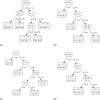Machine learning reveals orbital interaction in materials
- PMID: 29152012
- PMCID: PMC5678453
- DOI: 10.1080/14686996.2017.1378060
Machine learning reveals orbital interaction in materials
Abstract
We propose a novel representation of materials named an 'orbital-field matrix (OFM)', which is based on the distribution of valence shell electrons. We demonstrate that this new representation can be highly useful in mining material data. Experimental investigation shows that the formation energies of crystalline materials, atomization energies of molecular materials, and local magnetic moments of the constituent atoms in bimetal alloys of lanthanide metal and transition-metal can be predicted with high accuracy using the OFM. Knowledge regarding the role of the coordination numbers of the transition-metal and lanthanide elements in determining the local magnetic moments of the transition-metal sites can be acquired directly from decision tree regression analyses using the OFM.
Keywords: Material descriptor; data mining; machine learning; magnetic materials; material informatics.
Conflict of interest statement
No potential conflict of interest was reported by the authors.
Figures





References
-
- Yousef S, Da G, Thanh N, et al. . Data mining for materials: computational experiments with compounds. Phys Rev B. 2012;85:104104.
-
- Yang S, Lach-hab M, Vaisman II, et al. . Identifying zeolite frameworks with a machine learning approach. Phys Chem C. 2009;113:21721–21725.
-
- Hautier G, Fischer CC, Jain A, et al. . Finding nature’s missing ternary oxide compounds using machine learning and density functional theory. Chem Mater. 2010;22:3762–3767.
-
- Snyder JC, Rupp M, Hansen K, et al. . Finding density functionals with machine learning. Phys Rev Lett. 2012;108:253002. - PubMed
-
- Isayev O, Fourches D, Muratov EN, et al. . Materials cartography: representing and mining materials space using structural and electronic fingerprints. Chem Mater. 2015;27:735–743.
LinkOut - more resources
Full Text Sources
Other Literature Sources
